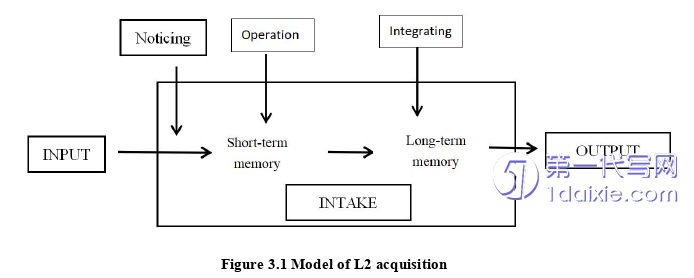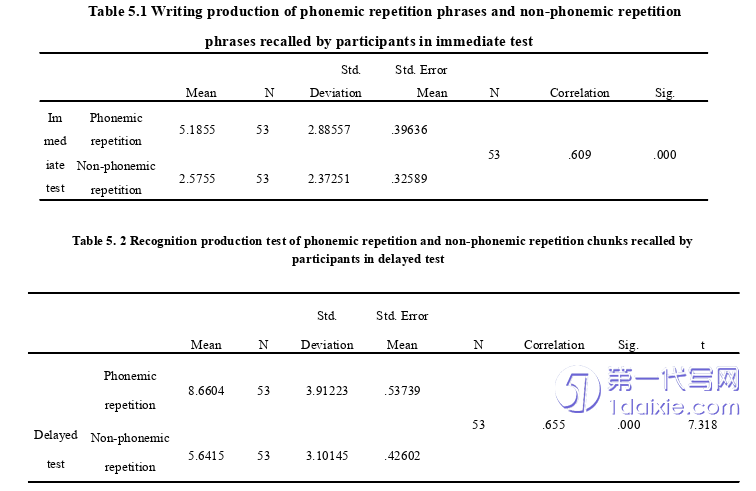本文是一篇英语论文,作者从理论和实践两个层面提出了以下建议。(1) 本文发现,音素重复对语块的产生和识别有积极的影响,但实际上,学习者面临着对语块意义的记忆。因此,音素的重复对汉语意义的影响仍有待进一步研究。(2) 中学英语教师,甚至在学生学习英语的时间相对较晚的学校,都应该在记忆块的过程中非常重视音素重复。学生在重复知识的指导下,将有能力将其应用于实践,并有利于语言学习。
Chapter 1 Introduction
1.1 Background of This Study
With the purpose of meeting the high requirements brought by globalization,Chinesestudents set down to learning English from a quite young age,even in their youth.On theother hand,when confronted with a large scale of vocabularies and collocations or whatEnglish teachers called phrases,learners are burdened with huge pressure of memorization.Meanwhile,researchers have made great efforts to seek for vocabularies mnemonicstrategies,of which phonics for young children highlights the relationship betweenphonological morphemes and their orthography.In China,it also gained its popularity.Besides,online vocabularies aims to make songs or doggerel with sound repetition tofacilitate words.Can these similarities in sounds facilitate memory in chunks as well?

In both students’and their instructors’view,the significance of vocabularies has beenput on a superior place.And according to the Chinese exam standard by the educationalministry,Chinese middle school learners should acquire at least 1600 words and 600 lexicalchunks or word unites which has been a headache for a junior learner.As what has beenstressed by linguists,students are required to acquire both vocabularies and lexical chunks ormulti-word unit(Lewis,2000;Nattinger&DeC arrico,1992;Schimitt,2004).With respectto Frank Boers and Seth Linstromberg(2012),the use of formulaic sequence has positivecorrelation with L2 learners’language proficiency,which exclusively emphasizes thesignificance of grasping lexical chunks.
1.2 Purposes of This Study
Previous studies did turn out a positive relation between alliteration and lexical chunklearning.Considerable evidences abroad proved its mnemonic effects not only in appliedlinguistics,but in advertisement,rhetoric,poetry,and oral literature.To expand the empiricalstudy by Boers and Lindstromberg,Chinese scholars conducted several studies to testwhether the mnemonic effect benefit foreign language learners.Targeted with Chineseuniversity students,Zhang Lei(2008)found alliteration can help the recognition of idioms,as for the meaning of English idioms,there exists no positive correlation.Still,juniormiddle school phase is the first stage when learners face the pressure of multi-word units.
In the present paper,junior middle school students were chosen as the participants tosee whether lexical chunks with phonemic repetition yield better effects in the process ofmemorizing the target chunks than those without any repetitive patterns.Thus,this paper isscheduled to answer the following questions.
(1)For middle school students,do lexical chunks with phonemic repetition yield bettermnemonic effects than those showing no repetitive sound patterns?
(2)In word repetition,perfect rhyme,alliteration,and assonance,which one has thestrongest mnemonic effect in an immediate writing production test while which one showsthe weakest effect?
(3)In word repetition,perfect rhyme,alliteration,and assonance which one has thestrongest mnemonic effect in a delayed recognition test while which one shows the weakesteffect?
Chapter 2 Literature Review
2.1 Related Studies on Lexical Chunks
Lexical chunks(Lewis,1993)were firstly put forward by Lewis in 1993.Besideslexical chunks,there are many other similar terms,such as semi-fixed patterns andlexicalized sentence stems(Pawley&Syder,1983)lexicalized sentence stems formulaicframes(Peters,1983)and etc.In the present study,the term“chunks”are employed mainly.
Lexical chunk,also called formulaic sequences,was derived from the concept of“chunking”which was a psychological term.According to related studies on the learning oracquisition of lexical chunks both abroad and inside of China within the past few decades,there has been a growing number of linguists and researchers burying themselves in seekingfor methodology and pedagogy on vocabularies,especially researches on formulaicsequences,not only in the aspect of applied linguistic but in other wide range of fieldsincluding phraseology lexicography,corpus linguistics,L1 and L2 acquisition,languageteaching,neurolinguistics and other disciplines(Schmmit,2004).
Firstly,the classification of chunks has been made by linguists.Nattinger&Decarrio(2007)divided lexical chunks into 4 categories.
(1)poly words:cannot be separated or replaced by any other words without changing themeaning of the originals,such as“by the way”“in a word”.
(2)institutional expressions:the linguists regarded them as sentence-level expressions,including proverbs,sayings,utterance formulaic language and so on.Most of them havefixed forms,thus cannot be changed.For example:“long time no see”,“a watched dog neverboils”,etc.like,“how do you do?”“a piece of cake”.
2.2 Previous Studies on Phonemic Repetition
For this part,first,some previous studies will be introduced and the conclusions will beanalyzed.An introduction of tip of tongue,phonological neighborhood density,suffix effect,and phonological Similarity were presented,which are followed by the studies made by Chinese researchers.
2.2.1 Definitions of Key Terms
Alliteration:Alliteration,which derives from Latin meaning“repeating andreappearance of the same letter,”is a figure of speech in which consonants,especially at thebeginning of words,or stressed syllables,are repeated.Here in the research,the traditionaldefinition of alliteration was employed.It stands for the reappearance of the initial soundwhich is always a consonant in two or more words that begin with the same letter,such as,first and foremost;saints and sinners;He came back sound and safe(Michael,2000).
Assonance:Assonance is one of the major poetic devices.It is also called an“imperfect rhyme,”“slant rhyme,”“near rhyme,”or“oblique rhyme.”According to Oxforddictionary,it begins with different consonant sounds and can be regarded as a special rhymein which the stressed syllables of middle vowels pronounce the same,however,thepreceding consonance sounds do not match.For example,in words such as“town”and“house”the consonant is very strong.The final consonant sounds remain similar,but theending vowel sounds are different in assonance.Similar to these two words“moon”and“run,”and in the following words“hold”and“bald,”the ending consonant sounds aresimilar,whereas vowel sounds are different.(Hornby,2000)
Chapter 3 Theoretical Framework..........................16
3.1 Noticing Hypothesis........................................16
3.2 Capacity Model of Attention.....................................18
Chapter 4 Methodology..........................................20
4.1 Research Questions...................................20
4.2 Participants.............................20
Chapter 5 Results and Discussion............................25
5.1 Results........................................25
5.1.1 Effects of Phonemic Repetition and Non-Phonemic Repetition......................25
5.1.2 Effects of Four Repetitions in the Immediate Test..........................28
Chapter 5 Results and Discussion
5.1 Results
In this part,the results of the immediate test and delayed test will be delivered.
5.1.1 Effects of Phonemic Repetition and Non-Phonemic Repetition
For the first research question,do lexical chunks with repetitive sound patterns such asalliteration,perfect rhyme,assonance,and word repetition yield better mnemonic effects inthe immediate writing production test will be answered in table 5.1,and 5.2 will extend theresults in the delayed test.

Conclusion
Major findings
As what have been discussed in the last 2 chapters,on the basis of the theories ofnoticing hypothesis and distinctiveness hypothesis.The research questions can be answered.
(1)For middle school students,do lexical chunks with phonemic repetition yield a bettermnemonic effect than those showing no repetitive sound patterns?
Chunks with repetitive sound patterns are more salient,thus it indeed facilitates thememorization.Both in the immediate test and in the delayed test for recognition,lexicalchunks with phonemic repetition yield better effects.
(2)In word repetition,perfect rhyme,alliteration,and assonance,which one has thestrongest mnemonic effect in an immediate writing production test while which one showsthe weakest effect?
For question 2,varied types of sound repetition have distinct effects on memorization.In the immediate test,word repetition yielded the best mnemonic effect,and the next isalliteration and the perfect rhyme,alliteration with a slight superiority over perfect rhyme.Atthe end comes the assonance.
reference(omitted)
